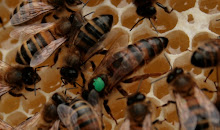I am attempting to make queens for four queenless hives by using the punch method of removing cells from a prolific donor hive and transplanting them into a queenless hive that will convert them into queen cells.
The photo below shows a super frame with the cells stuck onto the bottom rail using a hot knife and wax.
The next photo shows the donor frame, with holes where the punch has been used to remove the cells.
Now we wait 19 days until the cells are ready for harvesting and use in the queenless hives. Well, that's the notion. This is the first time that I have done this, so I am pessimistic. The cells were hard to handle and I may have damaged them.
If you have used this method, let me know how you got on through the comments button.
The photo below shows a super frame with the cells stuck onto the bottom rail using a hot knife and wax.
The next photo shows the donor frame, with holes where the punch has been used to remove the cells.
Now we wait 19 days until the cells are ready for harvesting and use in the queenless hives. Well, that's the notion. This is the first time that I have done this, so I am pessimistic. The cells were hard to handle and I may have damaged them.
If you have used this method, let me know how you got on through the comments button.











